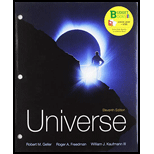
Concept explainers
(a)
The orbital period of the cloud, if a gas cloud located in the spiral arm of a distant galaxy has an orbital velocity of 400 km/s while moving in a circular orbit and the distance from the center of the galaxy is 20,000 pc.
(a)
Answer to Problem 26Q
Solution:
Explanation of Solution
Given data:
For a gas cloud located in the spiral arm of a distant galaxy, the orbital velocity is
Formula used:
The expression for time taken by an object in circular motion to complete an orbit is,
Here,
Conversion from km/s to m/s is performed as,
Conversion from pc to m is performed as,
Conversion from 1 s to 1 year is performed as,
Hence,
Explanation:
Write the expression for the period of the cloud’s orbit around the galactic center.
Substitute
Further, solve as,
Conclusion:
Therefore, the orbital period of the cloud is
(b)
The mass of the galaxy contained within the cloud’s orbit, if a gas cloud located in the spiral arm of a distant galaxy has an orbital velocity of 400 km/s while moving in a circular orbit and the distance from the center of the galaxy is 20,000 pc.
(b)
Answer to Problem 26Q
Solution:
Explanation of Solution
Given data:
For a gas cloud located in the spiral arm of a distant galaxy, the orbital velocity is
Formula used:
The expression for mass of our galaxy within the cloud is,
Here,
The value of
Conversion from km/s to m/s is performed as,
Conversion from pc to m is performed as,
Explanation:
Recall the expression for mass of our galaxy within the cloud.
Substitute
Conclusion:
Therefore, the mass of our galaxy within the cloud is
Want to see more full solutions like this?
Chapter 22 Solutions
Universe - Text Only (Looseleaf)
- Where might the gas and dust (if any) in an elliptical galaxy come from?arrow_forwardThe Sun orbits the center of the Galaxy in 225 million years at a distance of 26,000 light-years. Given that a3=(M1+M2)P2 , where a is the semimajor axis and P is the orbital period, what is the mass of the Galaxy within the Sun’s orbit?arrow_forwardSuppose the Sun orbited a little farther out, but the mass of the Galaxy inside its orbit remained the same as we calculated in Exercise 25.19. What would be its period at a distance of 30,000 light-years?arrow_forward
- Suppose three stars lie in the disk of the Galaxy at distances of 20,000 light-years, 25,000 light-years, and 30,000 light-years from the galactic center, and suppose that right now all three are lined up in such a way that it is possible to draw a straight line through them and on to the center of the Galaxy. How will the relative positions of these three stars change with time? Assume that their orbits are all circular and lie in the plane of the disk.arrow_forwardIf astronomers were to find they have made a mistake and our solar system is actually 7.8 (rather than 8.2) kpc from the center of the galaxy, but the orbital velocity of the sun is still 240 km/s, what is the minimum mass of the galaxy? (Hint: Use Kepler's third law.)arrow_forwardthe sun has an orbital speed of about 220kms^-1 around the centre of the galaxy , whose distance is 28 000 light years.estimate the total mass of the galaxy in solar massesarrow_forward
- why do you have to know the distance to a galaxy to find its mass?arrow_forwardAstronomers estimate the mass of the stars in a certain galaxy to be about 3.0e40 kg, and the total mass of this galaxy to be about 1.2e41 kg. The amount of the galaxy’s mass is made up of dark matter is_____ percent.arrow_forwardA star at a distance of 50000 light years from the center of a galaxy has an orbital speed of 100 km/s around the galactic center. What is the total mass of the galaxy located at distances smaller than 50000 light years from the center? A. 7.6 ×1010 solar masses B. 4.2 ×1011 solar masses C. 3.5 ×1010 solar masses D. 1.4 ×1011 solar masses Is the answer C? M = (r x v^2) / G = 50000 x 9.46e15 x (100000^2) / 6.67e-11 / 2e30 (the Sun's mass) = 3.55e10 solar massesarrow_forward
- A star near the visible edge of a galaxy travels in a uniform circular orbit. It is 43,500 ly (light-years) from the galactic center and has a speed of 275 km/s. a.)Estimate the total mass of the galaxy based on the motion of the star. Gravitational constant is 6.674×10−11m3/(kg·s2) and mass of the Sun Ms=1.99 × 1030 kg. b.)The total visible mass (i.e., matter we can detect via electromagnetic radiation) of the galaxy is 1011 solar masses. What fraction of the total mass of the galaxy is visible, according to this estimate?arrow_forwardThe gas in the outer region of the Andromeda galaxy is found to be orbiting the galaxy with a velocity of 250 km/s. The gas is at a distance of 35 kpc from the center of the galaxy. The total mass of the galaxy is _______ solar masses.arrow_forward
 AstronomyPhysicsISBN:9781938168284Author:Andrew Fraknoi; David Morrison; Sidney C. WolffPublisher:OpenStax
AstronomyPhysicsISBN:9781938168284Author:Andrew Fraknoi; David Morrison; Sidney C. WolffPublisher:OpenStax Foundations of Astronomy (MindTap Course List)PhysicsISBN:9781337399920Author:Michael A. Seeds, Dana BackmanPublisher:Cengage Learning
Foundations of Astronomy (MindTap Course List)PhysicsISBN:9781337399920Author:Michael A. Seeds, Dana BackmanPublisher:Cengage Learning Stars and Galaxies (MindTap Course List)PhysicsISBN:9781337399944Author:Michael A. SeedsPublisher:Cengage Learning
Stars and Galaxies (MindTap Course List)PhysicsISBN:9781337399944Author:Michael A. SeedsPublisher:Cengage Learning Physics for Scientists and Engineers: Foundations...PhysicsISBN:9781133939146Author:Katz, Debora M.Publisher:Cengage Learning
Physics for Scientists and Engineers: Foundations...PhysicsISBN:9781133939146Author:Katz, Debora M.Publisher:Cengage Learning



